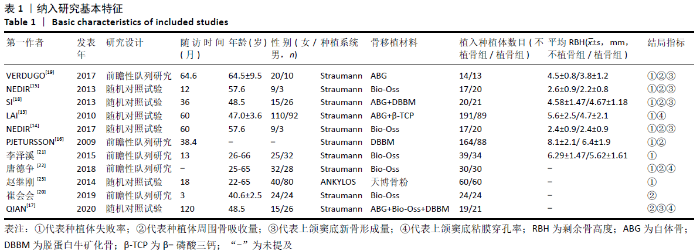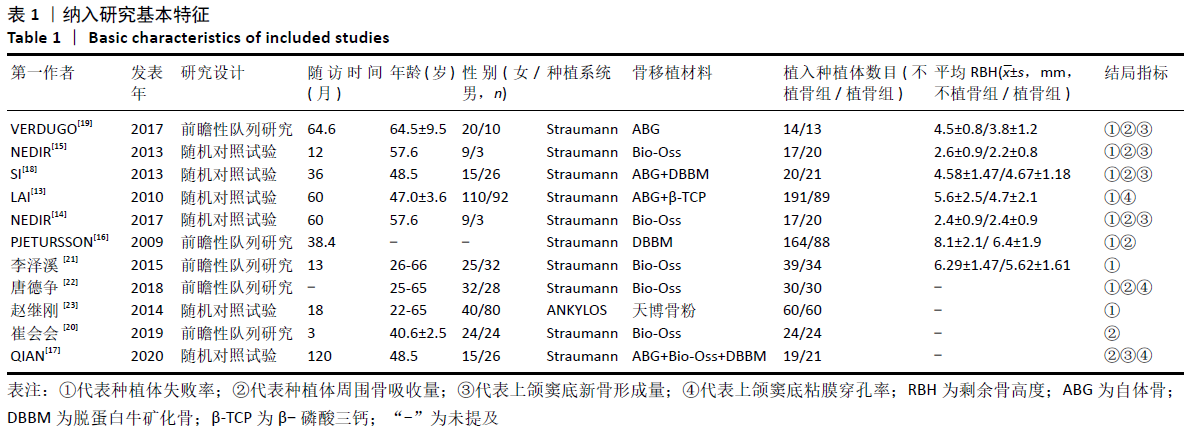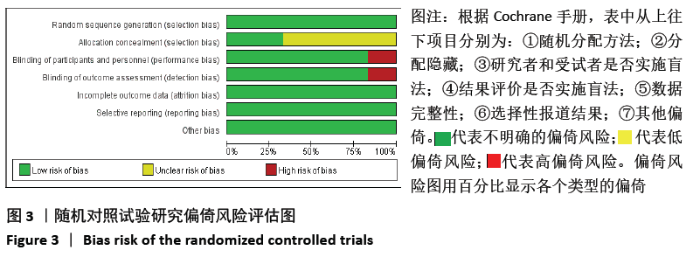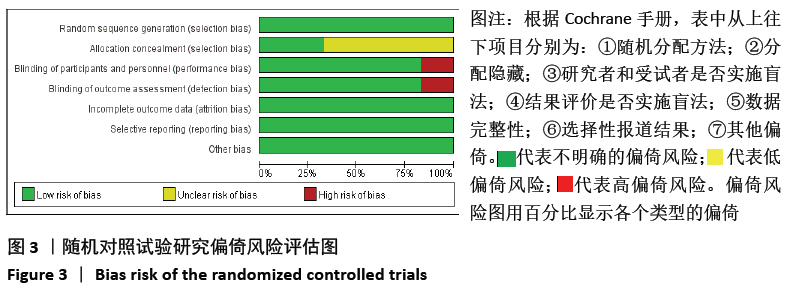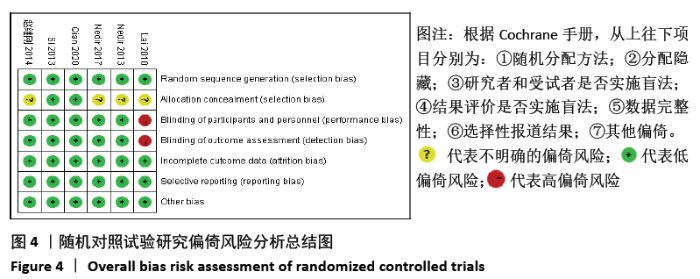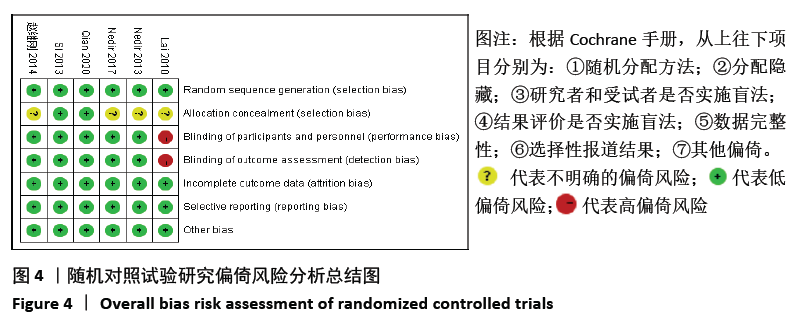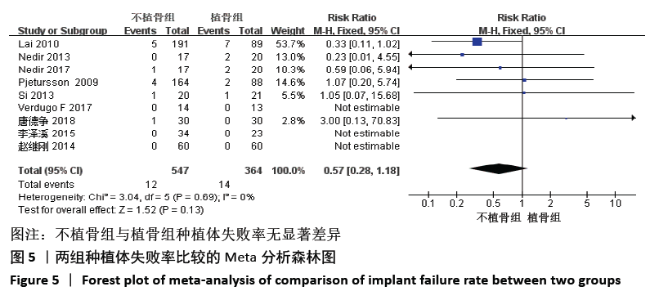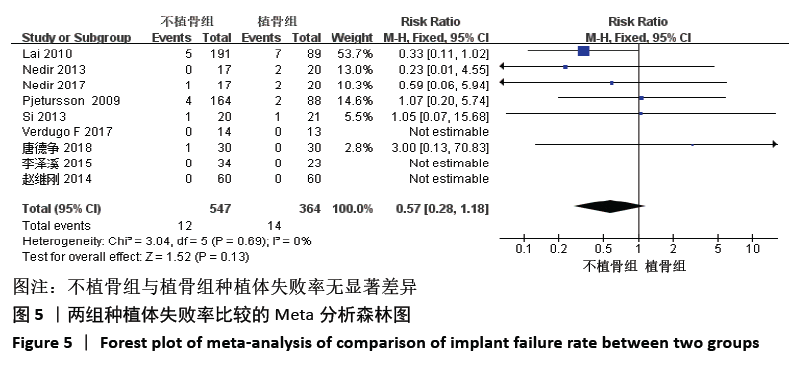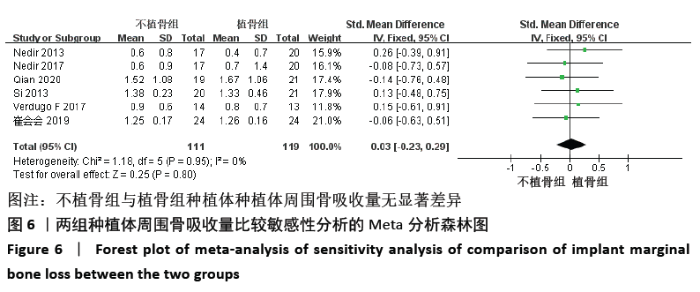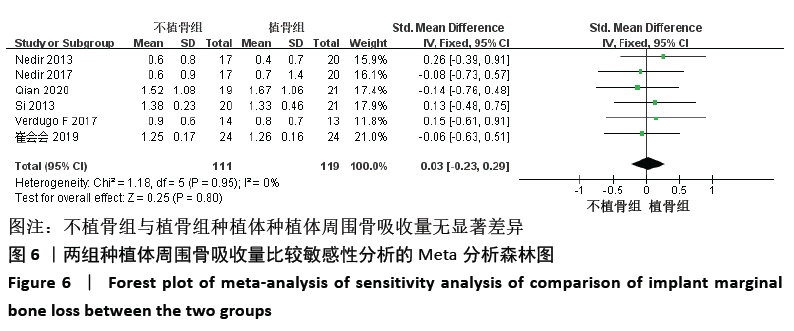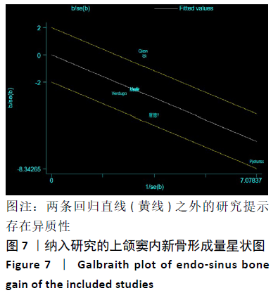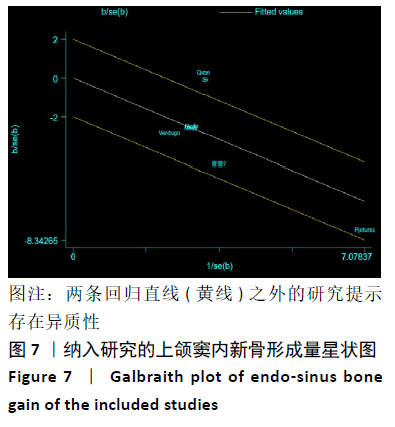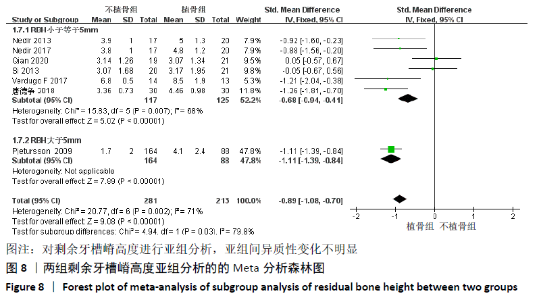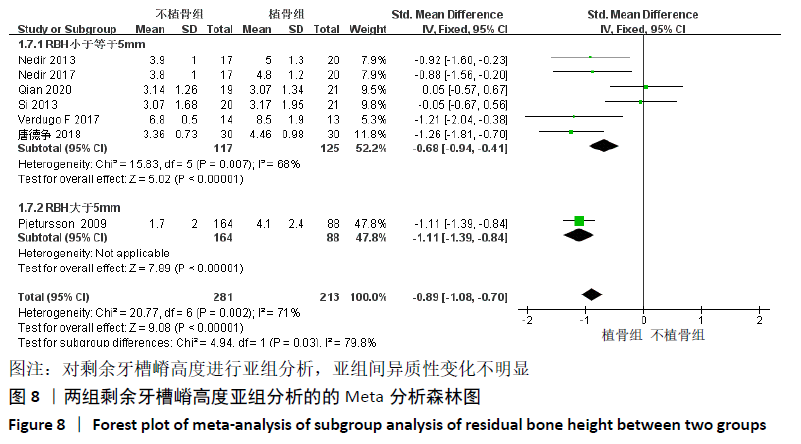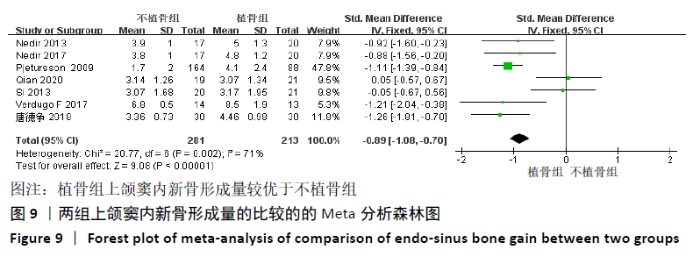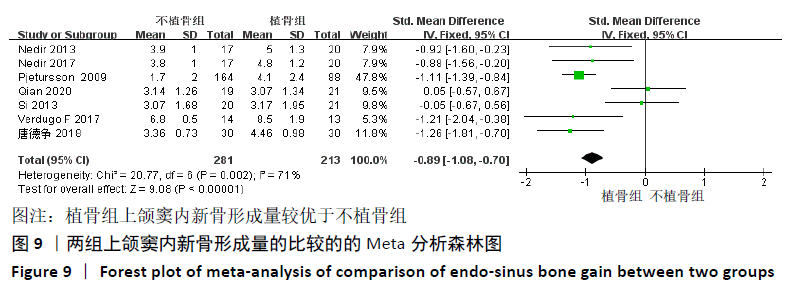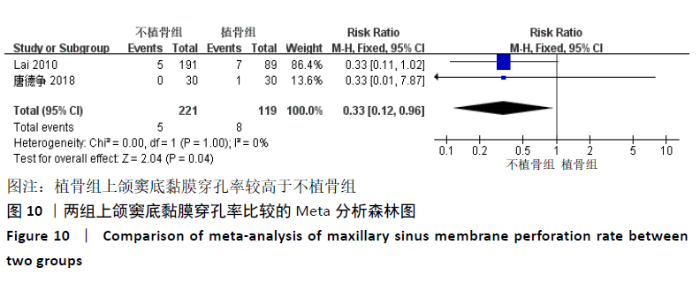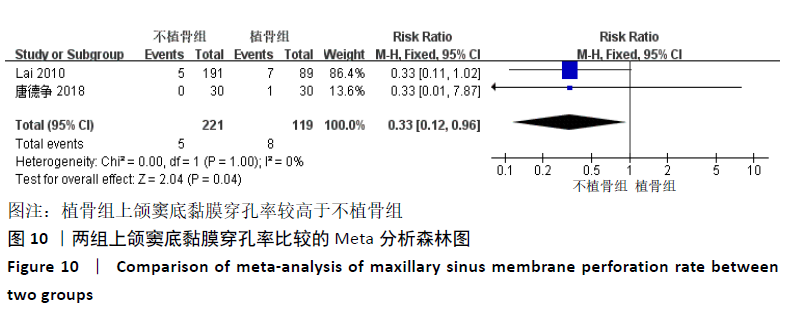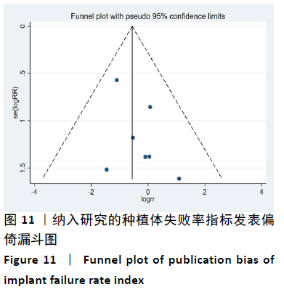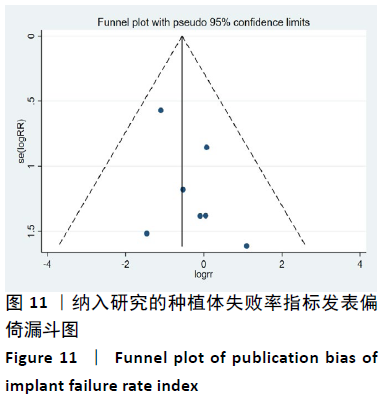Chinese Journal of Tissue Engineering Research ›› 2021, Vol. 25 ›› Issue (34): 5570-5576.doi: 10.12307/2021.256
Transalveolar sinus floor elevation with or without grafting materials: a meta-analysis
Shi Qianhui, Wu Chao, Zhou Qian, Qi Yuhan, Huo Hua, Liao Jian
- School/Hospital of Stomatology of Guizhou Medical University, Guiyang 550004, Guizhou Province, China
-
Received:2020-08-07Revised:2020-08-11Accepted:2020-09-19Online:2021-12-08Published:2021-07-28 -
Contact:Liao Jian, MD, Master’s supervisor, Associate professor, Associate chief physician, School/Hospital of Stomatology of Guizhou Medical University, Guiyang 550004, Guizhou Province, China -
About author:Shi Qianhui, Master candidate, School/Hospital of Stomatology of Guizhou Medical University, Guiyang 550004, Guizhou Province, China -
Supported by:Guizhou Provincial Natural Science Foundation, No. LH [2016]7257 (to LJ)
CLC Number:
Cite this article
Shi Qianhui, Wu Chao, Zhou Qian, Qi Yuhan, Huo Hua, Liao Jian. Transalveolar sinus floor elevation with or without grafting materials: a meta-analysis[J]. Chinese Journal of Tissue Engineering Research, 2021, 25(34): 5570-5576.
share this article
Add to citation manager EndNote|Reference Manager|ProCite|BibTeX|RefWorks
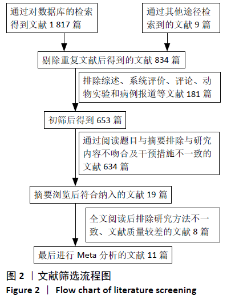
2.1 文献筛选结果 文献检索初步共检出相关文献1 817篇:中国知网34篇,CBM 97篇,万方340篇,维普8篇,PubMed 174篇,Embase 236篇,The Cochrane Library 134篇,Web of science 794篇。此外通过参考文献追溯手动检索获得文献9篇。删去重复文献后余下834篇文献,阅读文献,排除基础研究、病案报道、综述和非对照研究等文献,剩余653篇文献;通过阅读题目与摘要排除与研究内容不吻合及干预措施不一致等文献后剩下19篇文献;再次逐一阅读全文,排除学位论文、文献质量较差、数据不完整的文献,最终纳入11篇文献[13-23],其中7篇为英文文献[13-19],4篇为中文文献[20-23];纳入不植骨组共计595枚种植体,植骨组共计420枚种植体。文献筛选流程见图2。"
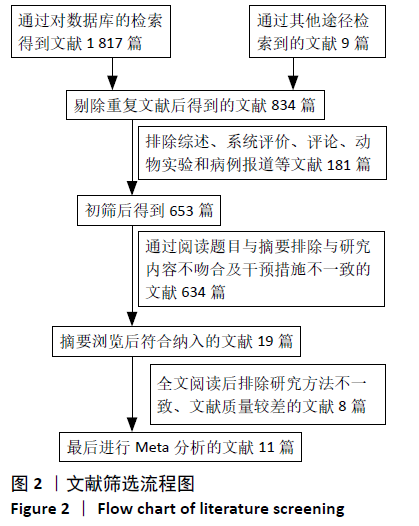
| [1] PJETURSSON BE, TAN WC, ZWAHLEN M, et al. A systematic review of the success of sinus floor elevation and survival of implants inserted in combination with sinus floor elevation. J Clin Periodontol. 2008;35(s8): 216-240. [2] PJETURSSON BE, LANG NP. Sinus floor elevation utilizing the transalveolar approach. Periodontol 2000. 2014;66(1):59-71. [3] SUMMERS RB. A new concept in maxillary implant surgery: the osteotome technique. Compendium. 1994;15(2):152,154-156. [4] FARRE-GUASCH E, PRINS HJ, OVERMAN JR, et al. Human maxillary sinus floor elevation as a model for bone regeneration enabling the application of one-step surgical procedures. Tissue Eng Part B Rev. 2013;19(1):69-82. [5] PIKOS MICHAEL A. Maxillary sinus membrane repair: update on technique for large and complete perforations. Implant Dent. 2008; 17(1):24-31. [6] TIMMENGA NM, RAGHOEBAR GM, WEISSENBRUCH RV, et al. Maxillary sinusitis after augmentation of the maxillary sinus floor: a report of 2 cases. J Oral Maxillofac. Surg. 2001;59(2):200-204. [7] SI MS, ZHUANG LF, Gu YX, et al. Osteotome sinus floor elevation with or without grafting: a 3-year randomized controlled clinical trial. J Clin Periodontol. 2013;40(4):396-403. [8] FRENCH D, NADJI N, SHARIATI B, et al. Survival and success rates of dental implants placed using osteotome sinus floor elevation without added bone grafting: a retrospective study with a follow-up of up to 10 years. Int J Periodontics Restorative Dent. 2016;36 Suppl:s89-s97. [9] BRIZUELA A, MARITIN N, FERNANDEZ F, et al. Osteotome sinus floor elevation without grafting material: results of a 2-year prospective study. J Clin Exp Dent. 2014;6(5):e479-e484. [10] GU YX, SHI JY, ZHUANG LF, et al. Transalveolar sinus floor elevation using osteotomes without grafting in severely atrophic maxilla: a 5-year prospective study. Clin Oral Implants Res. 2016;27(1):120-125. [11] HE L, CHANG X, LIU Y. Sinus floor elevation using osteotome technique without grafting materials: a 2-year retrospective study. Clin Oral Implants Res. 2013;24(A100):63-67. [12] STANG A. Critical evaluation of the Newcastle-Ottawa scale for the assessment of the quality of nonrandomized studies in meta-analyses. Eur J Epidemiol. 2010;25(9): 603-605. [13] LAI HC, ZHUANG LF, LV XF, et al. Osteotome sinus floor elevation with or without grafting a preliminary clinical trial. Clin Oral Implants Res. 2010;21(5):520-526. [14] NEDIR R, NURDIN N, ABI NAJM S, et al. Short implants placed with or without grafting into atrophic sinuses: the 5-year results of a prospective randomized controlled study. Clin Oral Implants Res. 2017;28(7):877-886. [15] NEDIR R, NURDIN N, KHOURY P, et al. Osteotome sinus floor elevation with and without grafting material in the severely atrophic maxilla. A 1-year prospective randomized controlled study. Clin Oral Implants Res. 2013;24(11):1257-1264. [16] PJETURSSON BE, IGNJATOVIC D, MATULIENE G, et al. Transalveolar maxillary sinus floor elevation using osteotomes with or without grafting material. Part II: Radiographic tissue remodeling. Clin Oral Implants Res. 2009;20(7):677-683. [17] QIAN SJ, Mo JJ, SI M, et al. Long-term outcomes of osteotome sinus floor elevation with or without bone grafting: the 10-year results of a randomized controlled trial. J Clin Periodontol. 2020;47(8):1016-1025. [18] SI MS, ZHUANG LF, GU YX, et al. Osteotome sinus floor elevation with or without grafting: a 3-year randomized controlled clinical trial. J Clin Periodontol. 2013;40(4):396-403. [19] VERDUGO F, URIBARRI A, LAKSMANA T, et al. Long-term stable vertical bone regeneration after sinus floor elevation and simultaneous implant placement with and without grafting. Clin Implant Dent Relat Res. 2017;19(6):1054-1060. [20] 崔会会,吴豪阳.上颌窦内提升术同期植骨与未植骨种植术后效果比较[J].河南医学研究,2019,28(11):36-38. [21] 李泽溪,王佐林.经牙槽嵴顶上颌窦底提升术中骨替代材料应用的临床疗效观察[J].口腔颌面外科杂志,2015,113(6):43-49. [22] 唐德争,马攀,刘长营,等.低矮上颌窦底内提升同期种植术植骨与不植骨的临床观察[J].首都医科大学学报,2018, 39(1):98-102. [23] 赵继刚,潘文仪,丁伟峰.上颌窦内提升术植骨与不植骨对种植体骨结合的影响[J].中华口腔医学研究杂志(电子版), 2014,8(6):480-484. [24] LUNDGREN S, ANDERSSON S, SENNERBY L. Spontaneous Bone Formation in the Maxillary Sinus after Removal of a Cyst: coincidence or consequence. Clin Implant Dent Relat Res. 2003;5(2):78-81. [25] MORASCHINI V, UZEDA MG, SARTORETTO SC, et al. Maxillary sinus floor elevation with simultaneous implant placement without grafting materials: a systematic review and meta-analysis. Int J Oral Maxillofac Surg. 2017;46(5):636-647. [26] ANDREAS T, LARS R, ANN W, et al. The role of whole blood in thrombin generation in contact with various titanium surfaces. Biomaterials. 2007;28(6):966-974. [27] 李芳,程余婷,黄晓林,等.上颌窦底骨增量是否需要使用骨移植材料[J].中国组织工程研究,2019,23(6):971-977. [28] FORNELL J, JOHANSSON LÅ, BOLIN A, et al. Flapless, CBCT-guided osteotome sinus floor elevation with simultaneous implant installation. I: radiographic examination and surgical technique. A prospective 1-year follow-up. Clin Oral Implants Res. 2015;23(1):28-34. [29] SROUJI S, KIZHNER T, DAVID D, BEN, et al. The Schneiderian membrane contains osteoprogenitor cells: in vivo and in vitro study. Calcif Tissue Int. 2009;84(2):138-145. [30] BASSI AP, PIOTO R, FAVERANI LP, et al. Maxillary sinus lift without grafting, and simultaneous implant placement: a prospective clinical study with a 51-month follow-up. Int J Oral Maxillofac Surg. 2015; 44(7):902-907. [31] CABAN J, FERMERGARD R, ABTAHI J. Long-term evaluation of osteotome sinus floor elevation and simultaneous placement of implants without bone grafts: 10-Year radiographic and clinical follow-up. Clin Implant Dent Relat Res. 2017;19(6):1023-1033. [32] GABBERT O, KOOB A, SCHMITTER M, et al. Implants placed in combination with an internal sinus lift without graft material: an analysis of short-term failure. J Clin Periodontol. 2009;36(2):177-183. [33] KIM SM, PARK JW, SUH JY, et al. Bone-added osteotome technique versus lateral approach for sinus floor elevation: a comparative radiographic study. Implant Dent. 2011;20(6):465-470. [34] LIN GH, LIM G, CHAN HL, et al. Recombinant human bone morphogenetic protein 2 outcomes for maxillary sinus floor augmentation: a systematic review and meta-analysis. Clin Oral Implants Res. 2016;27(11):1349-1359. [35] TAN WC, LANG NP, ZWAHLEN M, et al. A systematic review of the success of sinus floor elevation and survival of implants inserted in combination with sinus floor elevation Part II: transalveolar technique. J Clin Periodontol. 2008;35(s8):241-254. [36] NOLAN PJ, FREEMAN K, KRAUT RA. Correlation between schneiderian membrane perforation and sinus lift graft outcome: a retrospective evaluation of 359 augmented sinus. Int J Oral Maxillofac Surg. 2013;72(1):47-52. [37] POMMER B, UNGER E, SUTO D, et al. Mechanical properties of the Schneiderian membrane in vitro. Clin Oral Implants Res. 2009;20(6):633-637. |
| [1] | Zhou Jihui, Li Xinzhi, Zhou You, Huang Wei, Chen Wenyao. Multiple problems in the selection of implants for patellar fracture [J]. Chinese Journal of Tissue Engineering Research, 2021, 25(9): 1440-1445. |
| [2] | Wang Debin, Bi Zhenggang. Related problems in anatomy mechanics, injury characteristics, fixed repair and three-dimensional technology application for olecranon fracture-dislocations [J]. Chinese Journal of Tissue Engineering Research, 2021, 25(9): 1446-1451. |
| [3] | Chen Junming, Yue Chen, He Peilin, Zhang Juntao, Sun Moyuan, Liu Youwen. Hip arthroplasty versus proximal femoral nail antirotation for intertrochanteric fractures in older adults: a meta-analysis [J]. Chinese Journal of Tissue Engineering Research, 2021, 25(9): 1452-1457. |
| [4] | Chen Jinping, Li Kui, Chen Qian, Guo Haoran, Zhang Yingbo, Wei Peng. Meta-analysis of the efficacy and safety of tranexamic acid in open spinal surgery [J]. Chinese Journal of Tissue Engineering Research, 2021, 25(9): 1458-1464. |
| [5] | Hu Kai, Qiao Xiaohong, Zhang Yonghong, Wang Dong, Qin Sihe. Treatment of displaced intra-articular calcaneal fractures with cannulated screws and plates: a meta-analysis of 15 randomized controlled trials [J]. Chinese Journal of Tissue Engineering Research, 2021, 25(9): 1465-1470. |
| [6] | Huang Dengcheng, Wang Zhike, Cao Xuewei. Comparison of the short-term efficacy of extracorporeal shock wave therapy for middle-aged and elderly knee osteoarthritis: a meta-analysis [J]. Chinese Journal of Tissue Engineering Research, 2021, 25(9): 1471-1476. |
| [7] | Xu Feng, Kang Hui, Wei Tanjun, Xi Jintao. Biomechanical analysis of different fixation methods of pedicle screws for thoracolumbar fracture [J]. Chinese Journal of Tissue Engineering Research, 2021, 25(9): 1313-1317. |
| [8] | Jiang Yong, Luo Yi, Ding Yongli, Zhou Yong, Min Li, Tang Fan, Zhang Wenli, Duan Hong, Tu Chongqi. Von Mises stress on the influence of pelvic stability by precise sacral resection and clinical validation [J]. Chinese Journal of Tissue Engineering Research, 2021, 25(9): 1318-1323. |
| [9] | Zhang Tongtong, Wang Zhonghua, Wen Jie, Song Yuxin, Liu Lin. Application of three-dimensional printing model in surgical resection and reconstruction of cervical tumor [J]. Chinese Journal of Tissue Engineering Research, 2021, 25(9): 1335-1339. |
| [10] | Zhang Yu, Tian Shaoqi, Zeng Guobo, Hu Chuan. Risk factors for myocardial infarction following primary total joint arthroplasty [J]. Chinese Journal of Tissue Engineering Research, 2021, 25(9): 1340-1345. |
| [11] | Wei Wei, Li Jian, Huang Linhai, Lan Mindong, Lu Xianwei, Huang Shaodong. Factors affecting fall fear in the first movement of elderly patients after total knee or hip arthroplasty [J]. Chinese Journal of Tissue Engineering Research, 2021, 25(9): 1351-1355. |
| [12] | Wang Jinjun, Deng Zengfa, Liu Kang, He Zhiyong, Yu Xinping, Liang Jianji, Li Chen, Guo Zhouyang. Hemostatic effect and safety of intravenous drip of tranexamic acid combined with topical application of cocktail containing tranexamic acid in total knee arthroplasty [J]. Chinese Journal of Tissue Engineering Research, 2021, 25(9): 1356-1361. |
| [13] | Xiao Guoqing, Liu Xuanze, Yan Yuhao, Zhong Xihong. Influencing factors of knee flexion limitation after total knee arthroplasty with posterior stabilized prostheses [J]. Chinese Journal of Tissue Engineering Research, 2021, 25(9): 1362-1367. |
| [14] | Huang Zexiao, Yang Mei, Lin Shiwei, He Heyu. Correlation between the level of serum n-3 polyunsaturated fatty acids and quadriceps weakness in the early stage after total knee arthroplasty [J]. Chinese Journal of Tissue Engineering Research, 2021, 25(9): 1375-1380. |
| [15] | Zhang Chong, Liu Zhiang, Yao Shuaihui, Gao Junsheng, Jiang Yan, Zhang Lu. Safety and effectiveness of topical application of tranexamic acid to reduce drainage of elderly femoral neck fractures after total hip arthroplasty [J]. Chinese Journal of Tissue Engineering Research, 2021, 25(9): 1381-1386. |
| Viewed | ||||||
|
Full text |
|
|||||
|
Abstract |
|
|||||
